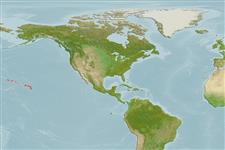>
Blenniiformes (Blennies) >
Blenniidae (Combtooth blennies) > Blenniinae
Etymology: Plagiotremus: Greek, plagios = oblique + Greek, trema = hole (Ref. 45335); goslinei: Named for Dr. William A. Gosline of the University of Hawaii..
Environment: milieu / climate zone / depth range / distribution range
Ökologie
seewasser riff-verbunden; tiefenbereich 1 - 15 m (Ref. 58302). Tropical
Eastern Central Pacific: Hawaiian Islands.
Size / Gewicht / Alter
Maturity: Lm ? range ? - ? cm
Max length : 6.4 cm SL Männchen/unbestimmt; (Ref. 3921)
Rückenflossenstacheln (insgesamt) : 11 - 12; Rückenflossenweichstrahlen (insgesamt) : 23 - 26; Afterflossenstacheln: 3; Afterflossenweichstrahlen: 20 - 21.
Adults are benthic or benthopelagic in or over coral (Ref. 58302). Common from the shallow waters to about 15 m. Taken with rotenone at 3-5 feet along rocky seashores where there was some sand bottom and where water circulation was good. Some specimens were collected from the stomachs of large fish (e.g. yellowfin tuna, Neothunnus macropterus) and from dolphins (Coryphaena hippurus) (Ref. 643). Oviparous. Eggs are demersal and adhesive (Ref. 205), and are attached to the substrate via a filamentous, adhesive pad or pedestal (Ref. 94114). Larvae are planktonic, often found in shallow, coastal waters (Ref. 94114).
Life cycle and mating behavior
Maturities | Fortpflanzung | Spawnings | Egg(s) | Fecundities | Larven
Oviparous, distinct pairing (Ref. 205).
Randall, J.E., 1985. Guide to Hawaiian reef fishes. Harrowood Books, Newtown Square, PA 19073, USA. 74 p. (Ref. 3921)
IUCN Rote Liste Status (Ref. 130435)
Bedrohung für Menschen
Harmless
Nutzung durch Menschen
Fischereien: kommerziell; Aquarium: Kommerziell
Tools
Zusatzinformationen
Download XML
Internet Quellen
Estimates based on models
Preferred temperature (Ref.
123201): 24.8 - 28.4, mean 25.4 °C (based on 36 cells).
Phylogenetic diversity index (Ref.
82804): PD
50 = 0.5005 [Uniqueness, from 0.5 = low to 2.0 = high].
Bayesian length-weight: a=0.00562 (0.00258 - 0.01228), b=3.06 (2.87 - 3.25), in cm total length, based on LWR estimates for this (Sub)family-body shape (Ref.
93245).
Trophic level (Ref.
69278): 4.0 ±0.7 se; based on size and trophs of closest relatives
Widerstandsfähigkeit (Ref.
120179): hoch, Verdopplung der Population dauert weniger als 15 Monate. (Preliminary K or Fecundity.).
Fishing Vulnerability (Ref.
59153): Low vulnerability (10 of 100).
Nutrients (Ref.
124155): Calcium = 183 [92, 342] mg/100g; Iron = 0.968 [0.544, 1.654] mg/100g; Protein = 18.3 [17.2, 19.4] %; Omega3 = 0.108 [0.055, 0.206] g/100g; Selenium = 19.1 [8.7, 45.1] μg/100g; VitaminA = 285 [96, 839] μg/100g; Zinc = 1.95 [1.24, 2.91] mg/100g (wet weight);
